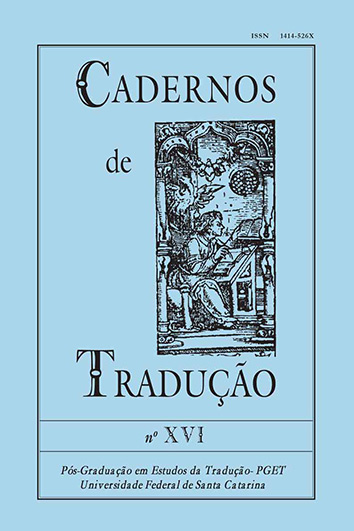Haroldo de Campos e Martin Buber como tradutores bíblicos: semelhanças e diferenças em suas agendas analisadas à luz da Teoria da Relevância.
DOI:
https://doi.org/10.5007/%25xAbstract
Este artigo objetiva analisar excertos da tradução do livro bíblico do Qohélet, realizada por Haroldo de Campos (1991), para o português, e por Martin Buber (1997), para o alemão. A análise pauta-se pelos princípios da Teoria da Relevância (Sperber & Wilson, 1986/1995) e pelos trabalhos de Gutt (1992/2000a/2000b) e Alves (2001a/2001b), que aplicam essa teoria aos Estudos da Tradução. Consoante sua agenda tradutória, Campos e Buber aspiram a uma hebraização de seus respectivos idiomas. Em vista disso, torna-se importante investigar semelhanças e diferenças em suas respectivas agendas e sua influência nos respectivos textos de chegada. Conceitos cruciais nesta abordagem são os de codificação conceitual e procedimental, pistas comunicativas e ambiente cognitivo.Downloads
Veröffentlicht
2005-01-01
Zitationsvorschlag
Neto, G. L. de C. (2005). Haroldo de Campos e Martin Buber como tradutores bíblicos: semelhanças e diferenças em suas agendas analisadas à luz da Teoria da Relevância. Cadernos De Tradução, 2(16), 105–128. https://doi.org/10.5007/%x
Ausgabe
Rubrik
Artigos
Lizenz
Copyright (c) 2005 Cadernos de Tradução

Dieses Werk steht unter der Lizenz Creative Commons Namensnennung 4.0 International.
Autores mantêm os direitos autorais e concedem à revista o direito de primeira publicação, com o trabalho simultaneamente licenciado sob a Licença Creative Commons Atribuição 4.0 Internacional (CC BY) que permite o compartilhamento do trabalho com reconhecimento da autoria e publicação inicial nesta revista.
Autores têm autorização para assumir contratos adicionais separadamente, para distribuição não exclusiva da versão do trabalho publicada nesta revista (ex.: publicar em repositório institucional ou como capítulo de livro, com reconhecimento de autoria e publicação inicial nesta revista).





















































